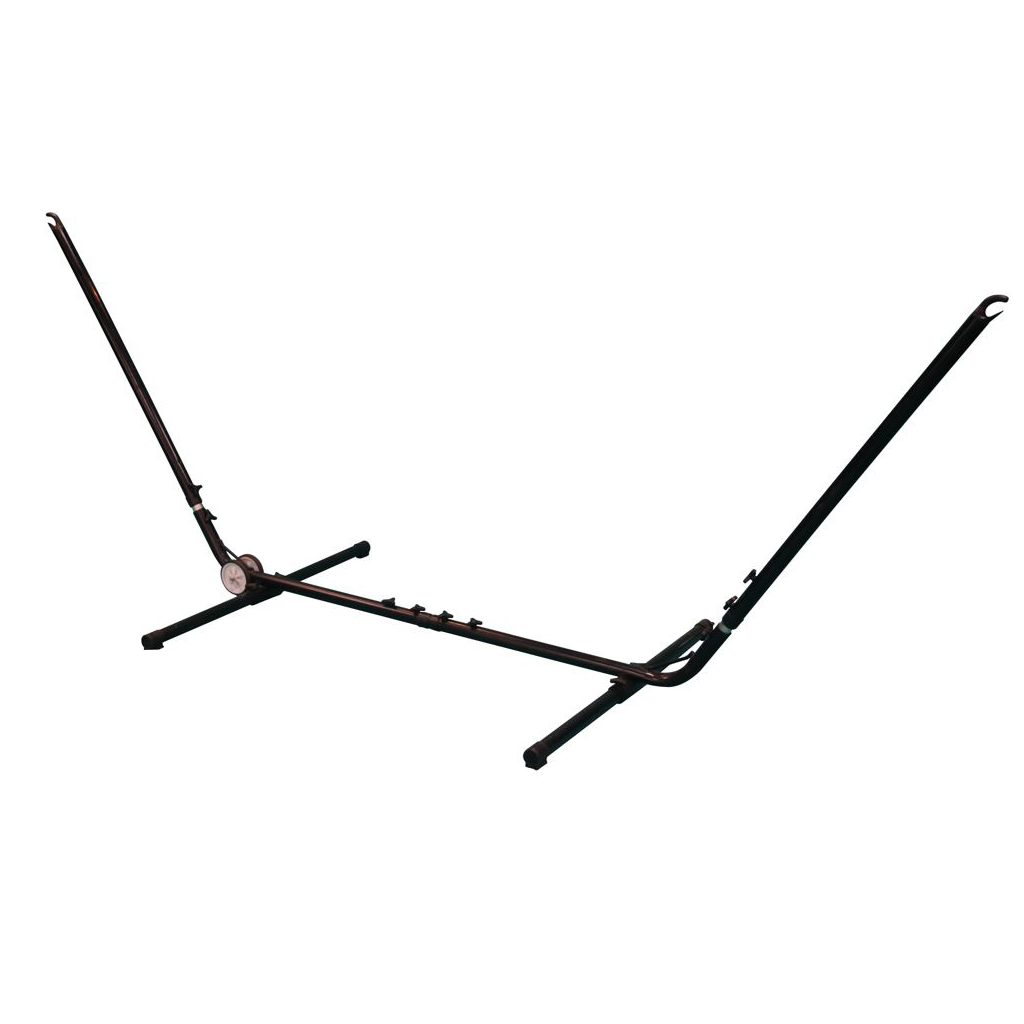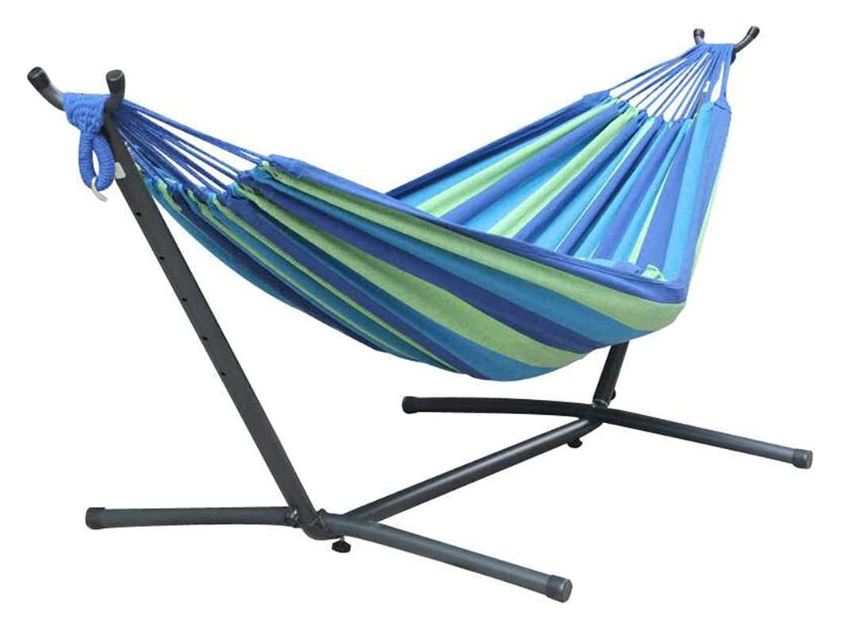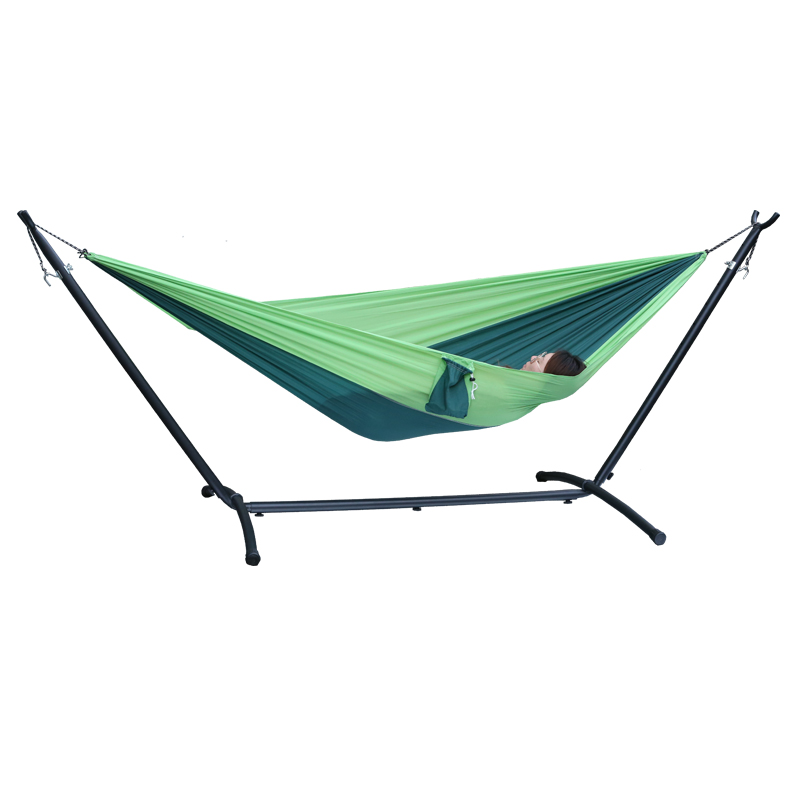
Why Choose a Hammock with Stand?
Hammocks have evolved from simple backyard accessories to stylish, versatile pieces of furniture. A hammock with a stand offers the ultimate relaxation experience without the need for trees or permanent fixtures. Hammocks have long been a symbol of relaxation and comfort. When combined with a stand, they offer unparalleled convenience and versatility. This guide delves into the world of hammocks with stands, highlighting their benefits, types, and essential factors to consider when choosing one.
The Types of the Hammocks with Stands.
Adjustable Hammock Stand: Custom Comfort
An adjustable hammock stand allows you to modify the height and tension for optimal comfort, catering to various hammock sizes and styles.

Cotton Hammock with Stand: The Classic Choice
Cotton hammocks are loved for their softness and breathability, making them ideal for warm climates and leisurely days.

Spreader Bar Hammock with stand: Why It’s a Great Choice
Spreader bar hammocks offer a more open and flat lying surface, perfect for those who prefer a more bed-like feel.

Outdoor Camping Hammocks with Stands: Ideal for Any Weather
Outdoor camping hammocks with stands are designed to withstand the elements, making them a durable and long-lasting addition to any garden or patio.

| Type of Hammock Stand | Pros | Cons |
|---|---|---|
| Adjustable Hammock Stand | – Versatile: Adjusts to fit various hammock sizes and styles. – Customizable comfort: Allows height and tension adjustments. – Convenient: Ideal for people who enjoy changing their hammock’s position or tightness. | – Complexity: Can be more complicated to set up compared to non-adjustable stands. – Cost: Often more expensive than fixed stands.<br>- Stability: May not be as stable as non-adjustable, heavy-duty stands. |
| Cotton Hammock | – Comfort: Known for their softness and comfort. – Breathability: Perfect for warm climates due to their airy material. – Classic Appeal: Traditional look and feel that appeals to hammock purists. | – Maintenance: Cotton can be less durable and may require more care. -Weather Sensitivity: Not ideal for prolonged outdoor use in wet conditions. – Fading: Color may fade over time with sun exposure. |
| Spreader Bar Hammock | – Flat Surface: Offers a more open and flat lying experience. – Easy Access: Easier to get in and out due to the spreader bar keeping it open. – Aesthetic: Often more visually appealing when set up due to its structured look. | – Stability: Can be less stable and more prone to flipping than traditional hammocks. – Space Requirement: Requires more space to set up due to its flat layout. – Rigidity: Some may find the taut surface less comfortable than traditional, gathered-end hammocks. |
| Outdoor Camping Hammock with Stand | – Durability: Built to withstand various weather conditions. – Portability: Often designed for easy transport for camping trips. – Versatility: Suitable for both outdoor and indoor use. | – Weight: Can be heavier due to sturdy construction. – Setup Time: May take longer to set up compared to other hammock types. – Cost: High-quality materials and durability can make them more expensive. |
What is the best free standing hammock?
Here’s the information about choosing the best free-standing hammock organized in a table format:
| Factor | Description |
|---|---|
| Material | Opt for durable materials like cotton, polyester, or Sunbrella fabric for balance in comfort and durability. |
| Frame | Should be sturdy, made from steel or heavy-duty aluminum for stability and longevity. |
| Weight Capacity | Ensure it supports your weight; standard ranges are between 250 to 500 pounds. |
| Size | Consider the size of both the hammock bed and the stand for fit and comfort. |
| Portability | If movement is required, look for lightweight and easy-to-assemble options. |
| Ease of Assembly | Choose hammocks that are simple to set up and dismantle, ideally without extra tools. |
| Additional Features | Look for features like a canopy for shade, side pockets, or options for two people, based on needs. |
| Price | Balance cost with quality; the most expensive option isn’t always the best. |
| Customer Reviews | Read reviews for real-life opinions on comfort, durability, and user-friendliness. |
This table provides a structured way to compare and evaluate different free-standing hammocks based on these important factors.
Can any hammock go on a stand?
Not all hammocks can go on any stand, as compatibility depends on several factors:
- Size and Length: The hammock length should match the stand’s size. A hammock that’s too long or too short won’t fit properly.
- Attachment Style: Some hammocks have spreader bars at the ends, while others are gathered-end hammocks. Stands are often designed specifically for one type or the other.
- Weight Capacity: The stand must be able to support the weight of the hammock and its occupants.
- Material: The material of both the hammock and the stand should be compatible, especially in terms of outdoor use and weather resistance.
- Stand Design: Certain hammock stands are designed with specific hammock types in mind. For example, a stand for a Brazilian hammock might not be suitable for a Nicaraguan hammock.
To ensure compatibility, it’s often best to purchase a hammock and stand as a set or to verify the specifications of both the hammock and the stand if purchasing them separately.
How long should a hammock stand be?
The length of a hammock stand should typically be about 2 feet longer than the total length of your hammock (including the ropes or suspension). This general rule ensures a good fit and appropriate tension. Here are some guidelines:
- For Hammocks with Spreader Bars: The stand should be roughly the same length as the hammock or slightly longer. Spreader bars keep the hammock stretched out, so the stand doesn’t need to be much longer than the hammock itself.
- For Hammocks without Spreader Bars: These hammocks typically sag more and require a longer stand. For example, if your hammock is 13 feet long (from end to end including suspension ropes), a 15-foot stand would be appropriate.
It’s essential to check the hammock’s specifications for the recommended stand length, as different styles and types may have specific requirements. Additionally, always consider the weight capacity of the stand in relation to the hammock and its occupants.
What is the size of the hammock stand need to buy?
To determine the size of the hammock stand you need to buy, you should consider the total length of your hammock, which includes the length of the hammock bed plus any ropes or suspension systems. Here’s a general guideline:
- Measure Your Hammock: First, measure the total length of your hammock from end to end, including the ropes.
- Add Extra Length: As a general rule, the hammock stand should be about 2 feet longer than the total length of your hammock. This extra length allows for the necessary tension and support.
- Specific Types:
- With Spreader Bars: If your hammock has spreader bars, the stand should be roughly the same length as the hammock or slightly longer.
- Without Spreader Bars: For hammocks without spreader bars (traditional hammocks that sag), the stand should be significantly longer than the hammock.
Example: If your hammock (including ropes) measures 13 feet, you should look for a stand that is approximately 15 feet in length.
Remember, these are general guidelines. Always refer to any specific recommendations provided by the hammock manufacturer, as some hammocks may have unique requirements based on their design and material.
How long should a hammock stand be?
The length of a hammock stand should generally be about 2 feet longer than the total length of the hammock, which includes the hammock bed plus any ropes or suspension systems. Here are some specific guidelines:
- Hammocks with Spreader Bars: If your hammock has spreader bars (which keep the hammock stretched out), the stand should be roughly the same length as the hammock or slightly longer.
- Hammocks without Spreader Bars: For hammocks without spreader bars (which typically sag more), the stand should be significantly longer than the hammock.
For example, if your hammock (including its ropes) is 13 feet in total length, a stand that is approximately 15 feet long would be suitable.
It’s important to always check the specific requirements of your hammock, as some may have particular needs based on their design, material, and intended use.
Read more: Top 5 Hammock Stand Manufacturer (jauntyleisure.com)

